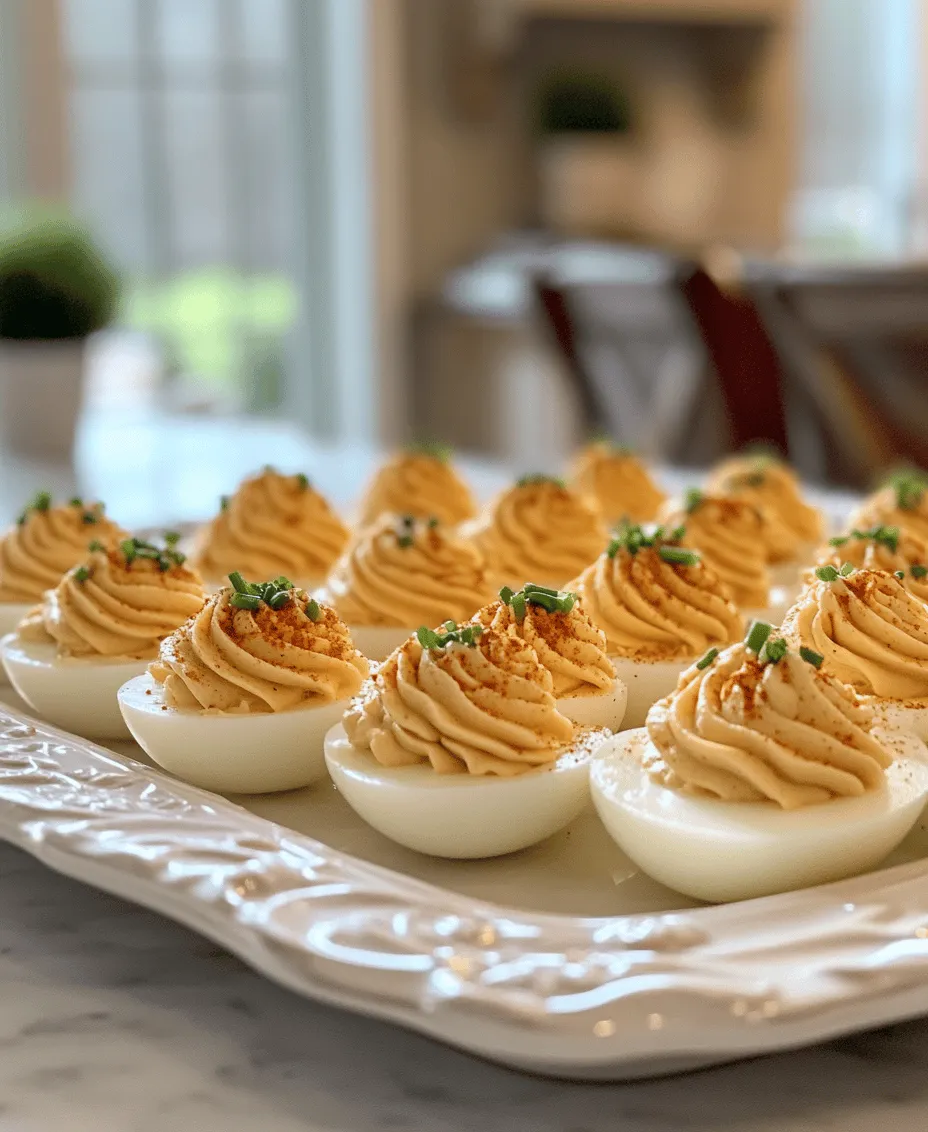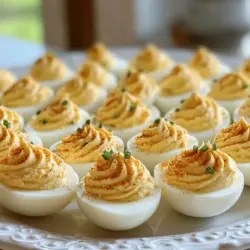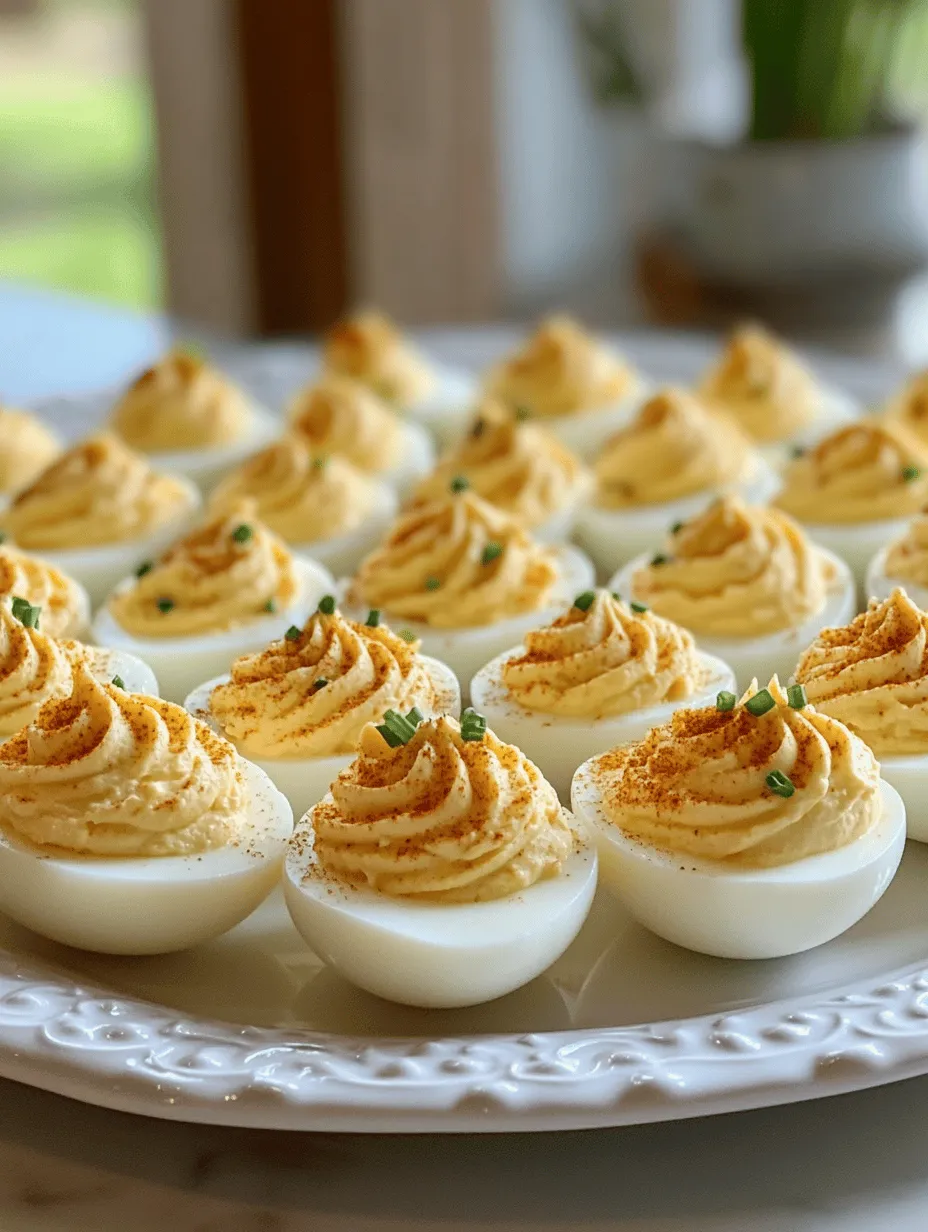Introduction
Deviled eggs are not just an appetizer; they are a culinary staple that has graced tables across the globe for generations. Their creamy texture, delightful flavors, and elegant presentation make them a go-to choice for various occasions, from casual picnics to sophisticated holiday gatherings. Whether you are hosting a family reunion, attending a potluck, or simply looking for a savory snack, deviled eggs have proven to be a crowd-pleaser.
When we talk about deviled eggs, we cannot overlook the charm of the “Eggcellent Classic Deviled Eggs” recipe. This version takes the traditional approach and elevates it with unique flavors that will tantalize your taste buds. With a perfect balance of creaminess and tanginess, each bite is an explosion of flavor that will leave your guests clamoring for more.
In this article, we will delve into the history and variations of deviled eggs, explore the nutritional benefits of the star ingredient—eggs—and provide a thorough breakdown of the ingredients that make this recipe stand out. We will also guide you through the initial steps to prepare the perfect deviled eggs that will impress your friends and family alike.
Understanding Deviled Eggs
History and Origin of Deviled Eggs
The history of deviled eggs can be traced back to ancient Rome, where boiled eggs were seasoned with various spices and served as appetizers. The term “deviled” emerged in the 18th century, primarily in reference to the spicy or zesty flavoring of dishes. The concept of deviled eggs evolved over time, with different cultures adapting the recipe to suit their tastes. In the United States, deviled eggs became particularly popular during the 1940s and 1950s, often appearing at family gatherings, church picnics, and holiday celebrations.
Variations of Deviled Eggs Around the World
Deviled eggs are not a one-size-fits-all dish; they boast an array of variations that reflect regional tastes and ingredient availability. In Spain, for example, you might find “huevos rellenos,” where the egg whites are filled with a mixture of the yolks, tuna, and mayonnaise. In Japan, “deviled eggs” can be made with wasabi for a spicy twist. Meanwhile, in the Middle East, the addition of spices like cumin and coriander can transform this classic dish into something entirely different. Each variation offers a unique perspective on this beloved appetizer, allowing for endless creativity in the kitchen.
Nutritional Benefits of Eggs as a Base Ingredient
Eggs are not only delicious, but they are also incredibly nutritious. They are an excellent source of high-quality protein, which is essential for muscle building and repair. One large egg contains about 6 grams of protein, making it a filling and satisfying ingredient. Additionally, eggs are rich in vitamins and minerals, including vitamin B12, vitamin D, and selenium. They also contain choline, which is vital for brain health and development. Including eggs in your diet can provide numerous health benefits, making deviled eggs a wholesome choice for any occasion.
Ingredients Breakdown
Creating the perfect Eggcellent Classic Deviled Eggs begins with understanding the essential ingredients. Using fresh, high-quality components is crucial for achieving the best flavor and texture. Let’s take a closer look at each ingredient and its role in this delightful recipe:
Large Eggs
The foundation of any deviled egg recipe, large eggs are essential for creating the filling. When selecting eggs, freshness is key. Fresh eggs will have a firmer white and a round yolk that sits high. This not only makes peeling easier but also results in a creamier filling. Aim for eggs that are organic or free-range, as they typically have richer flavors and better nutritional profiles.
Mayonnaise
Mayonnaise is the secret ingredient that adds creaminess to the deviled egg filling. It acts as a binder, bringing together the yolks and other ingredients to create a smooth, luscious texture. When choosing mayonnaise, consider using a high-quality brand or even homemade mayonnaise for a fresher taste. You can also experiment with different types, such as avocado or vegan mayo, for a healthier twist.
Dijon Mustard
A spoonful of Dijon mustard introduces a tangy kick to the filling, enhancing the overall flavor profile. The sharpness of Dijon mustard complements the richness of the mayonnaise and eggs, resulting in a well-balanced taste. If you prefer a milder flavor, you can adjust the amount or substitute it with yellow mustard, although it may alter the final taste slightly.
Apple Cider Vinegar
Adding acidity is essential in balancing flavors, and apple cider vinegar does just that. A dash of this tangy vinegar brightens the overall taste of the deviled eggs and helps cut through the richness of the other ingredients. It also adds a subtle fruitiness that enhances the dish without overpowering it.
Smoked Paprika
Smoked paprika is the ingredient that takes these deviled eggs from ordinary to extraordinary. This spice adds a depth of flavor and a hint of smokiness that elevates the dish. Not only does it provide a beautiful color, but it also adds an aromatic quality that is simply irresistible. Feel free to adjust the amount based on your preference for smokiness.
Chives
Chives are the finishing touch that adds freshness and visual appeal to your deviled eggs. Their mild onion flavor complements the richness of the filling without overwhelming it. Chopped chives sprinkled on top also add a pop of color that makes the dish visually enticing.
Step-by-Step Instructions to Perfect Deviled Eggs
Now that we’ve explored the ingredients that make up our Eggcellent Classic Deviled Eggs, it’s time to move on to the preparation process. The key to perfect deviled eggs lies in the cooking and handling of the eggs. Here’s a detailed guide to ensure your eggs turn out perfectly every time.
Detailed Guide for Boiling the Eggs
1. Choose Your Eggs Wisely: Start with large, fresh eggs for the best results. Ideally, you should use eggs that are about a week old, as they peel more easily than fresher eggs.
2. Boiling Process: Place your eggs in a single layer in a pot and cover them with cold water. Ensure there is at least an inch of water above the eggs. Slowly bring the water to a boil over medium heat. Once the water reaches a rolling boil, cover the pot with a lid and turn off the heat. Let the eggs sit in the hot water for about 9 to 12 minutes, depending on how well-done you prefer your yolks.
3. Timing and Temperature: Be mindful of the timing; overcooking the eggs can lead to a greenish ring around the yolk and a rubbery texture. For a creamy yolk with a slight softness, aim for the lower end of the time range.
Cooling Process
Once the eggs have finished cooking, it’s crucial to cool them rapidly to make peeling easier.
1. Ice Water Bath: Prepare a bowl filled with ice and cold water. After the eggs are done, carefully transfer them into the ice water bath using a slotted spoon. Let them sit for at least 5 to 10 minutes. This will stop the cooking process and help contract the egg whites, making peeling a breeze.
Peeling the Eggs
The peeling process can sometimes be a delicate task, but with the right techniques, you can achieve smooth, unblemished egg whites.
1. Crack and Roll: Gently tap each egg on a hard surface to crack the shell. Then, roll the egg between your hands to loosen the shell.
2. Start at the Wider End: Begin peeling from the wider end where there is usually an air pocket. This can help separate the shell from the egg white more easily.
3. Use Running Water: If you encounter stubborn bits of shell, try peeling the eggs under a gentle stream of running water. The water can help dislodge the shell fragments without damaging the egg white.
By following these steps, you will be well on your way to creating the perfect base for your Eggcellent Classic Deviled Eggs. Once your eggs are peeled and ready, you can move on to mixing the filling, which will be covered in the next part of this article. Stay tuned for more exciting details on how to assemble and serve these delicious appetizers!

Importance of Peeling Under Running Water
Peeling hard-boiled eggs can often feel like a daunting task, especially when the shells stick stubbornly to the egg whites. One effective technique to simplify this process is to peel the eggs under running water. This method works wonders as the running water helps separate the thin membrane from the egg white, making it much easier to remove the shell without damaging the delicate egg. Simply hold the egg under cool running water while gently tapping it against a hard surface to crack the shell, then proceed to peel. This will not only save you time but also preserve the integrity of your egg whites, which is crucial for creating beautifully presented deviled eggs.
Preparing the Filling
Once your eggs are peeled, it’s time to prepare the filling that will make your deviled eggs truly exceptional. Start by placing the egg yolks in a mixing bowl. For a classic deviled egg filling, you’ll want to add mayonnaise, mustard, vinegar, salt, and pepper. However, the key to achieving a smooth and creamy texture lies in how you mix these ingredients.
How to Achieve a Smooth Texture When Mixing Yolks and Other Ingredients
To get that ideal smooth texture, first, use a fork or a potato masher to break up the egg yolks until they are finely crumbled. Gradually add in the mayonnaise and mustard while mixing continuously. This gradual approach helps to emulsify the ingredients, preventing clumps and ensuring a velvety filling. For an even smoother result, consider using a food processor; simply pulse the yolks and wet ingredients until you reach the desired consistency. Remember to taste as you go, adjusting the quantities of mayonnaise and mustard based on your preference for creaminess and tanginess.
Tips for Adjusting Flavors to Personal Taste
Deviled eggs are incredibly versatile, and customizing the flavors is part of the fun. If you prefer a bit more heat, consider adding a dash of hot sauce or cayenne pepper. For a touch of sweetness, a small amount of dill pickle relish or finely chopped sweet pickles can enhance the flavor profile beautifully. Fresh herbs like chives, dill, or parsley can also be added for a refreshing twist. Always taste your filling before stuffing it into the egg whites, adjusting the seasoning as necessary to ensure it’s just right for your palate.
Filling the Egg Whites
Now that your filling is perfectly seasoned and smooth, it’s time to fill the egg whites. This can be done in a couple of ways, depending on your desired presentation and ease of use.
Options for Filling (Spoon vs. Piping Bag)
The simplest method is to use a small spoon to carefully scoop and fill each egg white half. This method is effective but can be a bit messy, especially if you’re making a large batch. For a more polished look, you might want to use a piping bag. Simply transfer the yolk mixture into the piping bag fitted with a star or round tip and pipe the filling into each egg white. This technique gives your deviled eggs a professional appearance and allows for more precise filling.
Creative Ideas for Presentation
When it comes to serving deviled eggs, presentation can make all the difference. Consider using a deviled egg tray, which features individual compartments for each egg half—this not only looks attractive but also helps keep them organized. If you don’t have a dedicated tray, you can create a bed of greens like arugula or lettuce on a platter and nestle the filled eggs among the leaves for an elegant touch. Additionally, you might consider topping each deviled egg with a sprinkle of smoked paprika or a slice of olive for a pop of color.
Garnishing for Visual Appeal
The visual presentation of your deviled eggs is just as important as the flavor. A beautiful plating can elevate the dish and make it more appetizing.
Importance of Presentation in Food
Humans eat with their eyes first, and this is especially true with appetizers. An appealing presentation can entice guests and create an inviting atmosphere at your gathering. Take a moment to arrange your deviled eggs thoughtfully, as this effort will be appreciated by your family and friends.
Suggestions for Additional Garnishes
In addition to smoked paprika, consider using fresh herbs like dill or cilantro to add a burst of color and flavor. Thinly sliced radishes can provide a crunchy contrast, while capers or pickled jalapeños can add a briny kick. For a touch of elegance, microgreens or edible flowers can be used as a garnish, making your deviled eggs stand out even more.
Serving Suggestions and Pairings
Deviled eggs are a classic dish that can be served at various occasions, making them a versatile addition to your recipe repertoire.
Ideal Occasions for Serving Deviled Eggs
These delightful bites are perfect for picnics, potlucks, brunches, and holiday gatherings. They’re easy to transport and can be made in advance, making them an ideal choice for any event where you want to impress your guests without spending hours in the kitchen.
Pairing Ideas with Beverages and Other Appetizers
When it comes to beverage pairings, deviled eggs complement a range of drinks, from crisp white wines to refreshing iced teas. For a more festive atmosphere, try serving them alongside cocktails like mimosas or Bloody Marys. In terms of food pairings, they work well with a variety of appetizers such as cheese platters, vegetable crudités, and charcuterie boards. The creaminess of the deviled eggs balances beautifully with crunchy and savory bites.
Creative Serving Options (Egg Trays, Platters)
Consider serving your deviled eggs on a multi-tiered serving platter for a stunning visual display. Alternatively, you can use a simple egg tray, which not only serves its purpose but also adds a charming touch to your table setting. For a rustic approach, you might opt for a wooden board topped with fresh herbs and the filled eggs arranged artfully around them.
Storing and Reheating Deviled Eggs
While deviled eggs are best enjoyed fresh, there may be times when you have leftovers. Knowing how to store them properly will ensure they remain safe and delicious.
Best Practices for Storing Leftover Deviled Eggs
To store leftover deviled eggs, place them in an airtight container. Separating layers with parchment paper can help prevent them from sticking together. Be sure to refrigerate them promptly to maintain freshness. They can typically be stored for up to two days, but for optimal taste and texture, aim to consume them sooner.
How to Keep Deviled Eggs Fresh and Safe to Eat
To keep deviled eggs fresh, store them in the coldest part of your refrigerator, ideally at a temperature below 40°F (4°C). Avoid leaving them out at room temperature for more than two hours to minimize the risk of foodborne illness. If you’re transporting them to a gathering, consider using an insulated cooler.
Tips for Reheating if Necessary
Generally, deviled eggs are best served cold and should not be reheated. If you must reheat them for any reason, do so gently in a microwave at low power for only a few seconds. Be cautious not to overheat, as this can affect the texture and flavor.
Common Mistakes to Avoid
Even the simplest recipes can have pitfalls. Here are some common mistakes to avoid when making deviled eggs.
Overcooking the Eggs: Effects on Texture and Flavor
One of the most common mistakes is overcooking the eggs. This can lead to a rubbery texture and unsightly greenish-gray rings around the yolk due to a chemical reaction between the yolk and the iron in the egg white. To avoid this, cook your eggs until just set and then cool them quickly.
Skipping the Cooling Process: Importance of Stopping Cooking
After boiling, it’s crucial to cool the eggs immediately in an ice water bath. This stops the cooking process and makes peeling easier. Skipping this step can result in overcooked eggs and difficulty in peeling.
Improper Seasoning: Balancing Flavors for the Perfect Bite
Flavor balance is key in deviled eggs. Be cautious with salt and acidity; too much of either can overwhelm the dish. Always taste your filling as you mix, and remember that you can adjust the seasoning to suit your taste preferences.
Presentation Pitfalls: Making Deviled Eggs Visually Appealing
Finally, don’t overlook the importance of presentation. Avoid using cracked or poorly filled eggs, as these can detract from the overall appeal. Take the time to arrange your eggs neatly and consider garnishing them to enhance their visual appeal.
Conclusion
In conclusion, Eggcellent Classic Deviled Eggs are not only delicious but also incredibly versatile, making them a fantastic addition to any gathering or as a delightful snack. With a few simple techniques and attention to detail, you can create a dish that is both visually stunning and bursting with flavor. Whether you’re making them for a holiday celebration, a family gathering, or just for yourself, this recipe is sure to be a hit. So gather your ingredients, follow the steps, and enjoy the joy of cooking and sharing these delightful bites with your loved ones. Deviled eggs are a timeless classic that never fails to impress. Don’t hesitate to try this recipe for your next event—you and your guests won’t be disappointed!



